Ice-breakers can help introduce familiarity, comfort, and trust within the classroom, making every child feel like they truly belong. Kids of all backgrounds can get to know each other better when they participate in get-to-know activities and initiatives. Ice-breakers for kids can also be adapted to fit any classroom, allowing your students to get a head start at the beginning of a new school year.
Math & ELA | PreK To Grade 5
Kids see fun.
You see real learning outcomes.
Watch your kids fall in love with math & reading through our scientifically designed curriculum.
Parents, try for free Teachers, use for free
What’s the Purpose of an Ice-breaker?

Ice-breakers are a great way to help kids overcome the initial hesitation of interacting with other children. You can introduce ice-breakers to help every child feel like a part of the classroom while zipping past the initial awkward stages of getting to know each other.
They’re especially effective in keeping shyer students engaged so that they feel like a part of a larger classroom environment. With greater engagement and a feeling of friendship within the classroom, kids can align themselves with different activities and initiatives quickly.
Remember: The goal of an ice-breaker activity is for the kids to have fun and get to know each other through interesting ways.
Related Reading: Best First Day of School Activities for Students
15 Interactive and Fun Get-to-Know-You Games for Kids
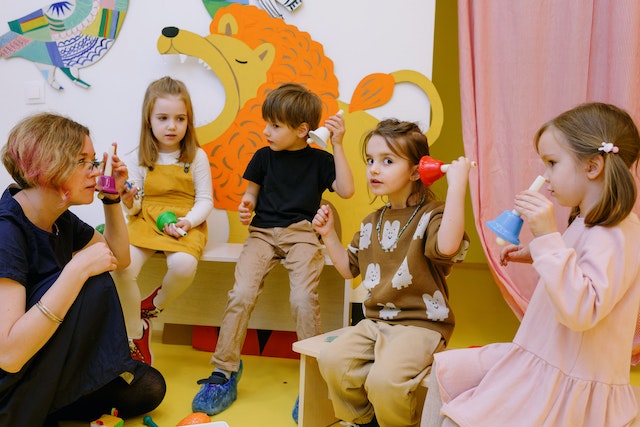
1. Circle Up, If You
One of the fun ice-breaker games for kids is the circle-up exercise. You can make five different colored circles and prepare ten questions. You can start by saying, “Run to the red circle if you love dogs.” You can make two circles intersect and ask who loves dogs and has a younger brother. Those who fulfill both criteria will be in the intersecting portion of the two circles.
Ideal Age Range: 4–8 years
Things Needed: Colored paper, stationery
2. M&Ms Ice-Breaker
You can hand out different colored M&Ms to your class, appoint a leader, and have them collect everyone holding the M&Ms of the same color. You can rotate the leaders around to ensure that everyone has a chance to take the lead.
Ideal Age Range: 4–5 years
Things Needed: M&M sweets
3. Introductions and Scavenger Hunt
You can have all students introduce themselves and discuss their favorite movies, pets, foods, etc. After that, you can start a scavenger hunt with the clues being the unique facts about each student. Your students can ask each other questions and find the right kid with the correct trait.
Ideal Age Range: 4–9 years
Things Needed: Traits/characteristics list
4. Monkey See, Monkey Do
You can have your students line up in a room and have them ask each other, “What are you doing?” one after the other. The kid answering the question sets the action for the others to follow. If he says, “I’m growling like a lion,” then everyone in the room must growl like a lion.
Ideal Age Range: 4–7 years
Things Needed: None
5. How Well Do You Know ‘em?

You can line up a row of chairs facing each other and have your students ask questions to each other based on a preset list. Questions can include things like “Where are you from?” or “What’s your favorite fruit?” You can have each partner recall the answer at the end of the exercise.
Ideal Age Range: 4–6 years
Things Needed: Chairs, list of questions
6. A Round of Whispers
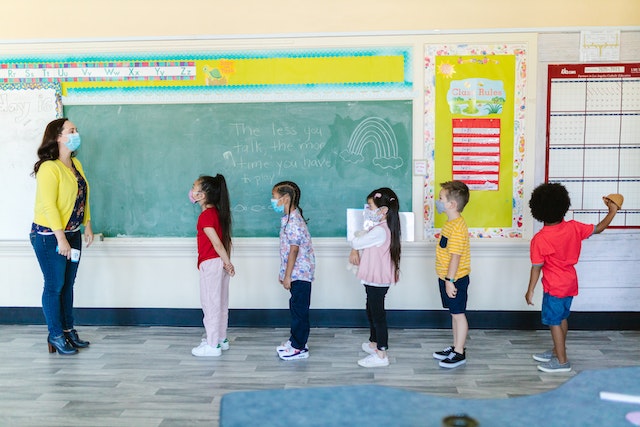
You can have kids sit behind one another in a row and whisper a phrase to the student in the front. They can whisper the phrase along, with the last child saying the phrase out loud. This is one of those fun ice-breakers for kids that everyone can participate in equally.
Ideal Age Range: 4–5 years
Things Needed: None
7. Hopscotch with a Twist
Kids can play hopscotch and land on different letters placed within the squares. From here, they need to announce a favorite toy, animal, hobby, or movie, beginning with that letter. For example, “d”: I love dinosaurs.
Ideal Age Range: 4–9 years
Things Needed: Chalk, toy
Related Reading: Best Classroom Games to Help Teachers Elevate Their Efforts
8. Match the Baby Picture
You can collect baby pictures of the students, print them out, and have your class guess whose picture belongs to whom. This is one of the most fun ice-breakers for kids, making every child feel special.
Ideal Age Range: 4–5 years
Things Needed: Baby pictures of the students
9. How Many Facts in 90 Seconds?

By pairing up kids, you can have them ask each other interesting facts about themselves with a timer of 90 seconds. You can have each partner recall the interesting facts at the end of each round, making it one of the more active ice-breakers for kids.
Ideal Age Range: 4–11 years
Things Needed: None
10. Toss It to Me!
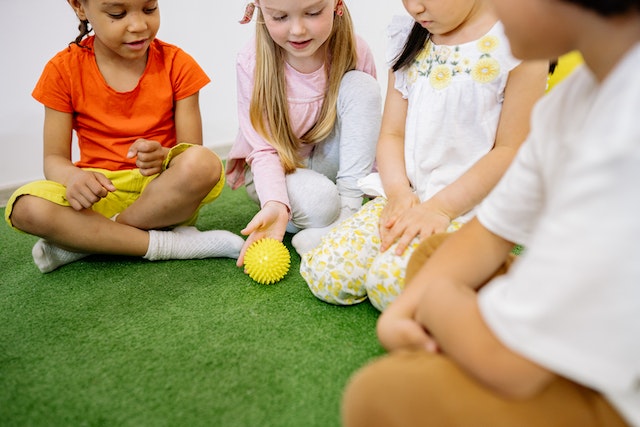
This is one of the simplest-to-set-up get-to-know-you games for kids, as it involves kids tossing a ball to each other by calling out the name of the person who needs to catch it. Your students need to ensure that the ball doesn’t drop, and they need to remember everyone’s names.
Ideal Age Range: 4–5 years
Things Needed: Ball
11. Hi-5 Someone with Brown Hair
You can give your students a range of different characteristics and what they need to do when they find a kid with that special characteristic. For example, “Dance with someone who’s the tallest in the class” or “Hug a kid who loves parrots.”
Ideal Age Range: 4–5 years
Things Needed: List of actions
12. What’s in Common Here?
Kids can try to make the biggest group possible of common characteristics and gather their team members on one side. The objective is to have a strong common parameter that all the kids in the group can relate to.
Ideal Age Range: 4–7 years
Things Needed: None
13. Personality Bingo!
You can print out a Bingo sheet with different unique characteristics and personality traits and have kids interact with each other about their interests. They can strike off specific boxes if they find someone who loves apples, enjoys parks, or loves to draw.
Ideal Age Range: 4–9 years
Things Needed: Bingo template cards
Related Reading: Best Online Art Games for Kids for Fun and Creativity
14. Animal Packs
You can print out index cards with different animal faces on them and hand them off to your class. Kids must make sounds representing the animal and form groups quickly to create their packs. You can make this activity more fun by adding jungle or forest background sounds.
Ideal Age Range: 4–5 years
Things Needed: Props, index cards
15. Would You Rather
This is one of the few ice-breakers for kids that can be done across grades. You can ask the class “Would You Rather”-style questions and have them discuss different answers based on their likes and dislikes. The discussion can be a great way to connect students from different backgrounds.
Ideal Age Range: 4–11 years
Things Needed: “Would You Rather”-style questions
15 of the Best Get-to-Know-You Activities for Kids
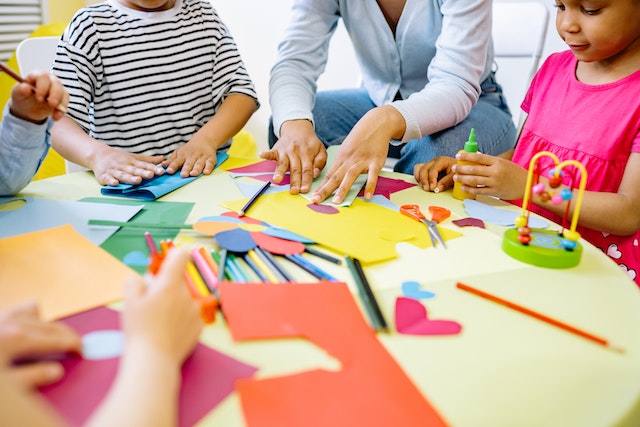
1. Draw My Life
You can have your kids draw themselves, their likes, their interests, their dreams, and a cool fact about them in a 4–5-page booklet. You can then have your students share their booklets with each other and talk about the different pages.
Ideal Age Range: 4–7 years
Things Needed: Empty booklet, stationery
2. Hello, I’m Mr. Bear
You can use a stuffed toy to role play as different students, can talk about themselves in funny voices through the toy. It can be passed around, and each kid can get a chance to talk about themselves.
Ideal Age Range: 4–5 years
Things Needed: Stuffed toy
3. This or That
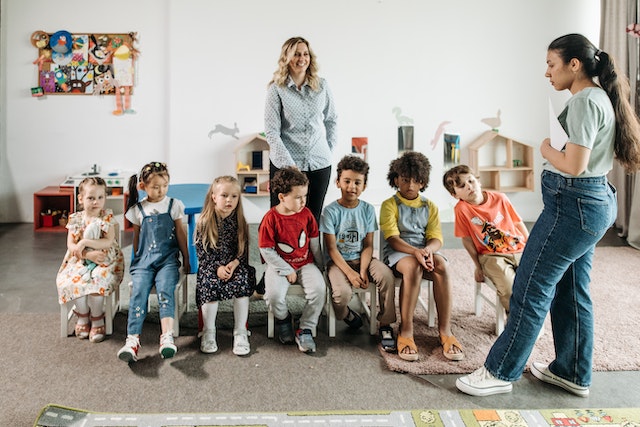
This is one of the most effective ice-breakers for kids, as it involves simply going from one side of the room to another. You can start by saying, “Dog lovers on the left, cat lovers on the right.” You can have them talk about why they like or dislike certain things and open up a dialogue.
Ideal Age Range: 4–11 years
Things Needed: None
4. Try Not to Laugh!
You can have your students sit in a circle for this activity and have each of them try to make the other one laugh. The other kids must stay silent as students use props, funny faces, silly dances, and goofy gestures to get them to laugh.
Ideal Age Range: 4–9 years
Things Needed: Props
5. The Candy Bowl Questions
Your students can pick out different types and numbers of candies from a bowl. You can then assign different types of candies as types of questions (family, hobbies, interests, etc.) and the quantity as the number of questions they must answer.
Ideal Age Range: 4–7 years
Things Needed: Candy, bowl
6. Show and Tell, Then Guess
You can have your students bring memorable items from home and have them talk about them. At the end of the show-and-tell activity, you can ask students to guess whose item belonged to whom. This is one of the best ice-breakers for kids when you’re looking to involve the entire class.
Ideal Age Range: 4–9 years
Things Needed: None
7. Share a Snack
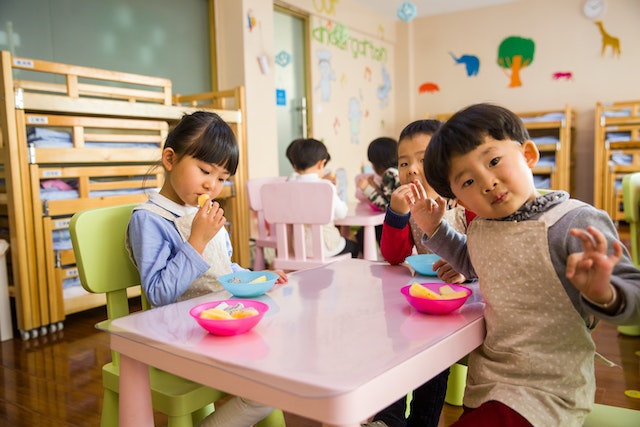
A great ice-breaker activity for kids is to have them share a part of their lunch or a snack with someone they don’t know in class. This can empower kids to seek out someone they haven’t interacted with before actively.
Ideal Age Range: 4–9 years
Things Needed: Snacks
8. Compliments on Every Fold
One of the most enjoyable ice-breaker activities for kids is to fold a sheet of paper five times and write a student’s name on the last fold. You can prepare them for the entire class and pass them around, mixing them up. You can ask your students to write something they like about that kid and unfold it before passing it ahead.
Ideal Age Range: 4–5 years
Things Needed: Paper, pencils
Related Reading: Best Positive Reinforcement Tips For Teachers & Parents
9. What Do I Want to Be?
You can have your students dress up as their desired profession. They can talk about why they want to be a doctor, a fireman, a lawyer, or a teacher, and empower them to talk about their aspirations with other kids.
Ideal Age Range: 4–9 years
Things Needed: Props, costumes
10. Connecting the Yarn
One of the easiest ice-breakers is the ball of yarn activity. You can have one student start off with facts about themselves and pass the ball of yarn over to someone who shares that personality trait or interest. Eventually, the entire class will be connected through the yarn showing the impact of connection.
Ideal Age Range: 4–11 years
Things Needed: Ball of yarn
11. Get-to-Know-Me Bag!
You can ask your students to take a brown paper bag home and fill it up with things that represent them. They can add toys, personal items, books, and other things that reflect their personality. You can go through each bag and have the entire class chime in with what the items could represent.
Ideal Age Range: 4–7 years
Things Needed: Brown paper bag
12. Finding the Partner Card
You can start by cutting out cards that have a partner card attached to them. For example, peanut butter, milk shakes, ice cream, etc. You can distribute them in class and have your students find their partner holding the card.
Ideal Age Range: 4–5 years
Things Needed: Cards, word list
13. A Storybook About Me
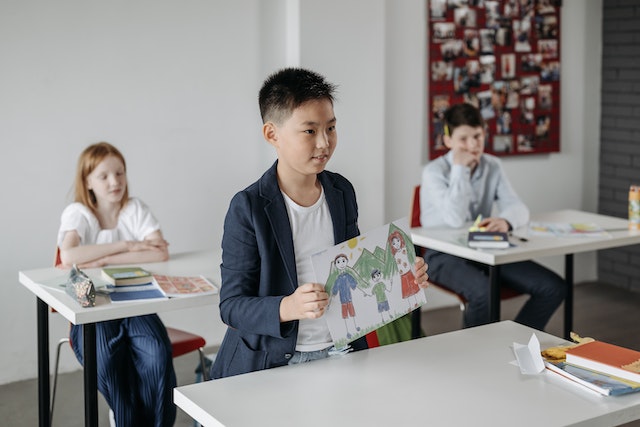
You can have your students create a storybook about their lives and draw out the best moments of their early lives. The storybook can be presented to the class, with each child getting a turn in talking about their lives through pictures.
Ideal Age Range: 4–7 years
Things Needed: Booklet template, pens, colors
Related Reading: Amazing Short Stories for Kids That Teach Beautiful Lessons
14. Drawing a Picture in a Group
Splitting up kids into groups and having them collectively draw a larger landscape can be a good ice-breaker for many of them. You can assign group objectives, such as drawing a park, drawing your school, drawing a beach day, etc.
Ideal Age Range: 4–8 years
Things Needed: Sheets of paper, crayons
15. The Sing-Along Activity
You can ask your students to sing the lyrics of nursery rhymes and popular children’s songs, one line at a time. This musical ice-breaker for kids can get them strumming to a tune within minutes and can help them overcome their shyness.
Ideal Age Range: 4–7 years
Things Needed: Instruments or speaker
Let’s Conclude
Many of these ice-breakers are easy to do and can be a part of any curriculum in any school. You can integrate them at the start of the year or when you notice that your class isn’t as active in discussions as before. You can also make these activities more fun by emphasizing the objective behind them so that they can actively learn through their actions. Get started now and use these thirty best ice-breakers to get kids to open up.
Explore more online educational resources for kids that will help with their learning experience and make them smarter.
Frequently Asked Questions (FAQs)
How can I improve participation among shyer kids?
You can encourage them to participate organically in exercises that are designed for class participation. You can also give them leadership roles and adequate rewards to promote regular engagement in kids.
When should I incorporate ice-breakers?
It’s best to have ice-breakers incorporated during the first week of school. You can also include these activities on group trips where different classes may meet for the first time.
How do I make ice-breakers more fun for kids?
You can include toys, props, instruments, books, and other items to provide a multisensory experience during ice-breakers. You can also emphasize silliness, and goofiness, and promote cooperative play to make them more fun.
What kinds of ice-breakers are most effective for younger students?
Get-to-know-me activities for kids that are simple, fun-filled, and involve the entire class are the most effective in engaging younger students.
























